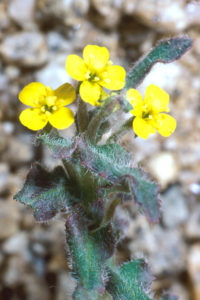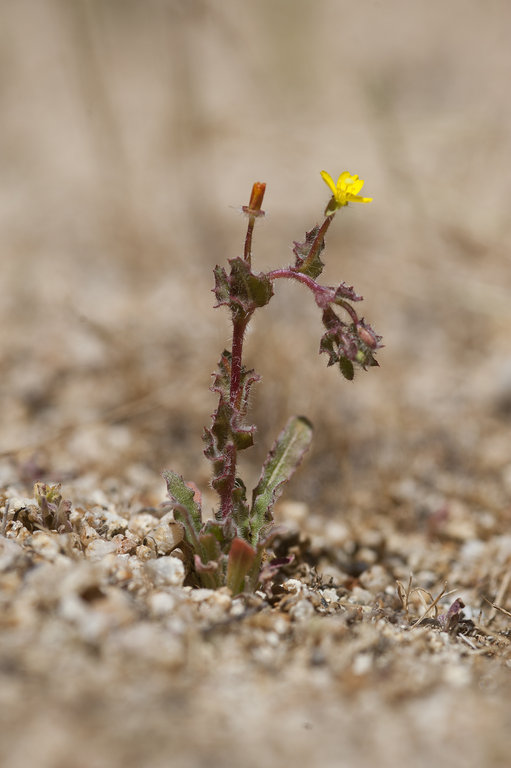Camissoniopsis hardhamiae
- Sensitive – U.S. Forest Service
- Rare Plant Rank 1B.2 – California Native Plant Society
- G2 Imperiled – NatureServe (2016)

© 1981 California Native Plant Society, courtesy CalPhotos
Description
Hardham’s evening-primrose is a member of the Onagraceae family (evening-primrose or willowherb). It is a leafy annual plant that can be found in only a handful of locations in San Luis Obispo and Monterey Counties. Like many other evening-primroses, Hardham’s is a short plant, typically growing less than 2 ft tall. Similar to thistles, its leaves form a low-lying, large rosette early in its growth cycle before producing a taller hairy stem. The leaves can grow up to five 5 in long, often with pinkish edges. This species is closely related to 16 other species of evening-primrose that can only be found in and around California. It is set apart from other species of evening-primrose growing in the area by its unique pollen, broader leaves, and genetic makeup.
If you are lucky enough to see this in the wild, you might see it blooming from March – May in the chaparral or woodland ecosystems between 460 – 3,000 ft in the inner Coast Ranges of San Luis Obispo and Monterey County. Hardham’s evening-primrose has been found in only one location in the Los Padres National Forest near Hi Mountain Lookout, but it may also grow in other areas of the forest where suitable habitat has not yet been surveyed. It sometimes colonizes areas that have been recently burned, but those small populations are usually much smaller several years later.
Name
Camissoniopsis hardhamiae was first described and named by botanist and environmentalist Peter Raven, former director of the Missouri Botanical Garden. Dr. Raven examined specimens collected from Sandy Valley in Monterey County and Calf Canyon in San Luis Obispo in the early 1960s and published a description in 1969. In that publication, he describes the reason for its name:
“Camissonia [later changed to Camissoniopsis] hardhamiae is named in honor of Clare B. Hardham of Paso Robles, California, enthusiastic student of the flora of the area where it grows. Mrs. Hardham has contributed much to our knowledge of the flora of her area through her numerous collections.”
P.H. Raven, Contributions from the United States National Herbarium, Volume 37 (1969)

© 2013 Chris Winchell, courtesy CalPhotos
Clare Butterworth Hardham was a well-known local botanist who, after receiving her M.S. from University of California Santa Barbara, extensively studied the flora of the Santa Lucia Range, Sierra Madre Range, and other areas of the Central Coast during the 1950s and 60s. She is also the namesake of Hardham’s bedstraw, another sensitive plant found in the Los Padres National Forest. Hardham was a good friend of Jim Blakley, a noted noted historian, author, and backcountry explorer of the Los Padres. She even named Blakley’s spineflower after him. It seems the many unique plants that inhabit the Los Padres National Forest were discovered by and named after equally unique botanists and true friends of the forest.
Threats
The Hardham’s evening-primrose, like many sensitive plant species, is threatened by development of roads and structures, mining, grazing, and invasive plant species. The California Native Plant Society also lists military activities, vehicles, and road maintenance as possible threats to the existence of this species that is found nowhere else on Earth. There has been at least one occurrence of Camissoniopsis hardhamiae that was severely impacted by herbicide spraying, scraping, and burning of its habitat. ForestWatch monitors any proposed activities that might affect this rare species, and works to ensure its continued existence in the Los Padres National Forest as well as elsewhere in its native range.






